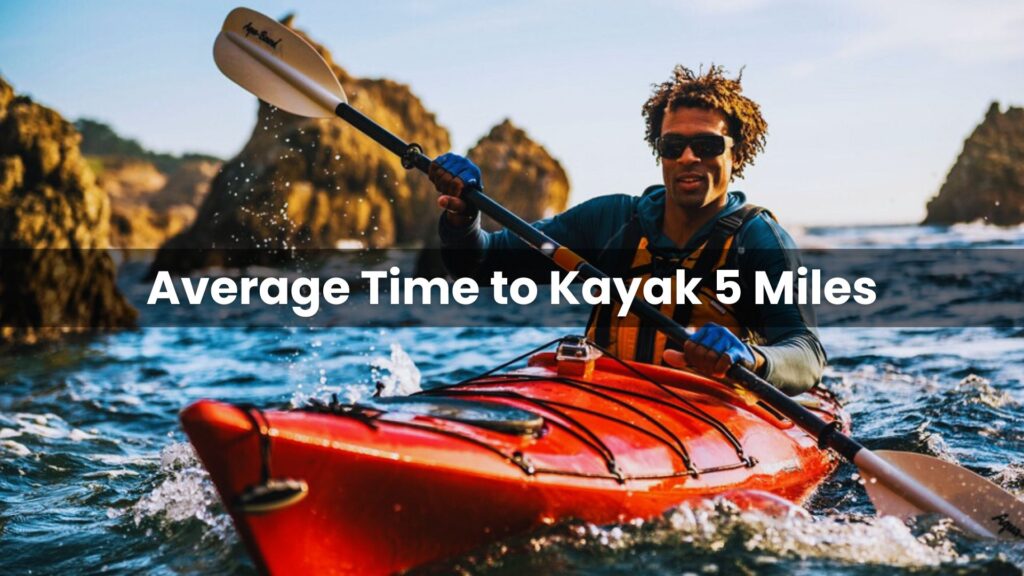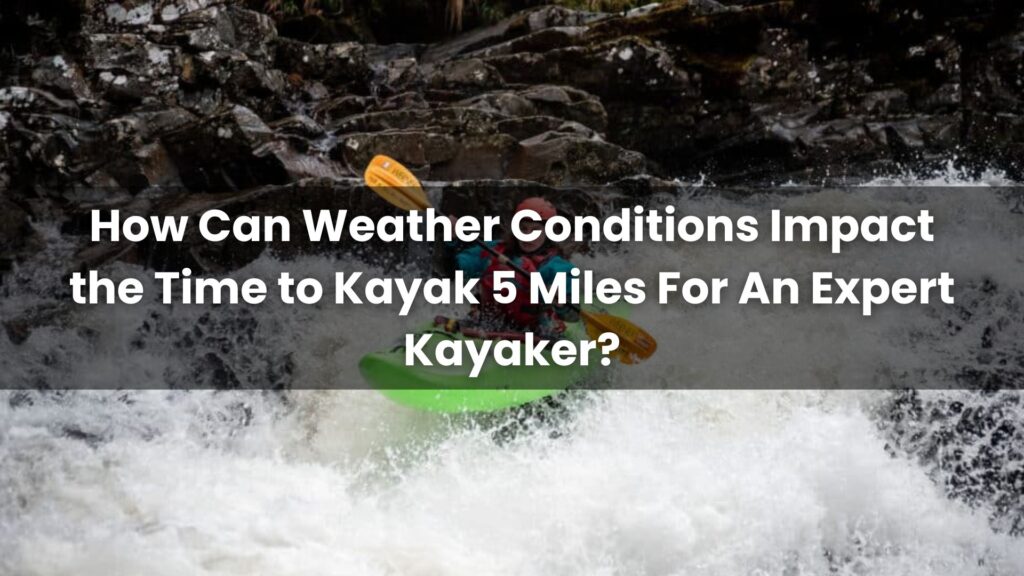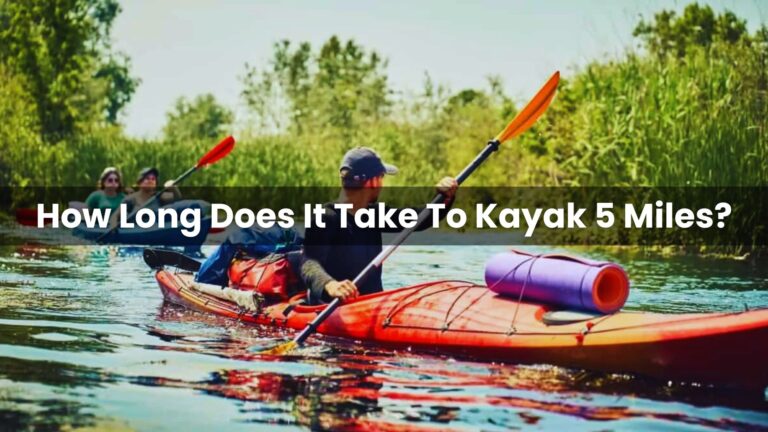Kayaking is a popular outdoor activity that offers a unique way to explore waterways and enjoy nature. One common question among kayakers is, How long does it take to kayak 5 miles? Understanding the factors that influence kayaking speed and knowing how to calculate your estimated time can help you plan your trips effectively and set realistic expectations.
When embarking on a 5-mile kayaking journey, it’s essential to consider various elements that can impact your speed and overall experience. Factors such as your physical fitness level, the type of kayak you use, weather conditions, water currents, and your skill level all play a role in determining how quickly you can cover the distance.
- Factors Affecting Kayaking Speed
- Calculating Kayaking Speed
- Average Time to Kayak 5 Miles
- Tips for Faster Kayaking
- Real-Life Scenarios
- How Can Weather Conditions Impact the Time to Kayak 5 Miles For An Expert Kayaker?
- What Are Some Tips For Improving Paddling Speed To Kayak 5 Miles Faster?
- How Does The Time To Kayak 5 Miles Vary Based On The Type Of Water (e.g. calm vs. choppy)?
- What Are Some Common Mistakes That Beginners Make When Trying To Kayak 5 Miles?
- What Are Some Tips For Beginners To Improve Their Paddling Speed For Kayaking?
- Frequently Asked Questions
- Conclusion
Factors Affecting Kayaking Speed

The time it takes to kayak 5 miles can vary depending on several factors, including:
Physical fitness level: A kayaker’s strength, endurance, and overall physical condition can significantly impact their speed and ability to maintain a consistent pace over long distances.
Type of kayak and paddle used: The design and materials of the kayak and paddle can affect their efficiency and speed. For example, a lightweight, streamlined kayak with a high-quality paddle may provide better performance than a heavier, less efficient setup.
Weather conditions: Wind, waves, and currents can either aid or hinder a kayaker’s progress. Favorable conditions can increase speed, while unfavorable conditions can slow down progress or even make kayaking unsafe.
Water currents and tides: The direction and strength of water currents and tides can greatly influence a kayaker’s speed. Paddling with the current or tide can significantly increase speed, while paddling against them can slow progress.
Skill level of the kayaker: Experienced kayakers who have mastered proper paddling techniques and have a good understanding of water dynamics can often maintain higher speeds and cover longer distances more efficiently than beginners.
Calculating Kayaking Speed
Calculate your kayaking speed, you can use the following formula:
Speed (in miles per hour) = Distance (in miles) / Time (in hours)
For example, if it takes you 2 hours to kayak 5 miles, your speed would be:
Speed = 5 miles / 2 hours = 2.5 miles per hour
It’s important to note that this formula provides an average speed and doesn’t account for changes in speed due to factors such as wind, waves, or currents.
Average Time to Kayak 5 Miles

When considering the average time it takes to kayak 5 miles, several factors come into play. For a moderately fit and experienced kayaker paddling in calm conditions, covering a distance of 5 miles typically ranges from 1.5 to 2.5 hours.
This estimate serves as a general guideline, but actual times can vary based on individual skill levels, the type of kayak and paddle used, weather conditions, water currents, and overall paddling efficiency.
Beginners or those facing less favorable conditions may find themselves taking longer to complete the same distance. It’s essential to understand that this average time is influenced by various variables, and each kayaking journey can present unique challenges and opportunities for improvement. By being mindful of these factors and continuously honing your skills, you can enhance your kayaking experience and strive for greater efficiency and enjoyment on the water.
Tips for Faster Kayaking
To improve your kayaking speed and efficiency, consider the following tips:
Practice proper paddling technique: Mastering the correct paddling form, such as keeping your back straight, using your core muscles, and maintaining a smooth, consistent stroke, can significantly increase your speed and reduce fatigue.
Maintain a steady pace: Paddling at a consistent speed, rather than alternating between fast and slow bursts, can help you cover longer distances more efficiently.
Utilize the kayak’s design for efficiency: Proper body positioning and weight distribution in the kayak can help you take advantage of the boat’s design and reduce drag.
Train for endurance and strength: Incorporating strength training exercises that target the muscles used in kayaking, such as the back, shoulders, and core, can improve your overall power and endurance.
Consider using a rudder or skeg: Some kayaks are equipped with a rudder or skeg, which can help you maintain a straight course and reduce the need for corrective strokes, ultimately increasing your speed.
Real-Life Scenarios
When it comes to real-life scenarios, the time it takes to kayak 5 miles can vary significantly based on the specific conditions encountered. Let’s explore a few examples to better understand how external factors can impact the duration of a 5-mile kayaking trip.
In a scenario where a kayaker faces strong headwinds and choppy waters, the journey may take considerably longer than the average time. The increased resistance from the wind and waves can slow down progress and require more effort to maintain a steady pace. In such cases, it’s not uncommon for the 5-mile trip to extend beyond the typical 1.5 to 2.5 hour range, potentially reaching 3 hours or more, depending on the severity of the conditions.
On the other hand, if a kayaker is fortunate enough to have favorable tailwinds and a strong current assisting their progress, they may be able to complete the 5-mile journey in a shorter time frame. In ideal conditions, with minimal resistance and maximum assistance from natural forces, a skilled kayaker could potentially cover the distance in as little as 1 to 1.5 hours. However, it’s crucial to exercise caution and not overestimate one’s abilities, as relying too heavily on external factors can lead to unexpected challenges and potential safety risks.
Real-life scenarios also highlight the importance of adaptability and decision-making skills for kayakers. When faced with changing conditions or unexpected obstacles, being able to adjust one’s approach and make informed choices can significantly impact the overall duration and success of a kayaking trip. By staying vigilant, assessing risks, and making prudent decisions, kayakers can navigate various scenarios more effectively and ensure a safe and enjoyable experience on the water.
How Can Weather Conditions Impact the Time to Kayak 5 Miles For An Expert Kayaker?

Weather conditions play a crucial role in determining the time it takes for an expert kayaker to cover a distance of 5 miles. Experienced kayakers understand the significant impact that weather factors, such as wind, waves, and currents, can have on their paddling speed and overall efficiency on the water.
Wind: Wind direction and strength can either aid or hinder a kayaker’s progress. For an expert kayaker, utilizing favorable tailwinds can significantly increase speed and reduce the time needed to kayak 5 miles. Conversely, paddling against strong headwinds can slow down progress and require more effort, potentially extending the duration of the journey.
Waves: Rough seas caused by high winds can create challenging conditions for kayakers. Expert kayakers must navigate through waves effectively, adjusting their paddling technique to maintain stability and forward momentum. Larger waves can slow down progress and increase the time required to cover 5 miles.
Currents: Water currents can either assist or impede a kayaker’s speed. Expert kayakers can strategically use fast-flowing currents to their advantage, allowing them to gain momentum and paddle faster. However, paddling against strong currents can be physically demanding and may prolong the time needed to complete the 5-mile journey.
What Are Some Tips For Improving Paddling Speed To Kayak 5 Miles Faster?
Enhance Paddling Technique: Focus on refining your paddling technique to increase efficiency and speed. Proper form, including using your core muscles, maintaining a smooth stroke, and optimizing your body positioning, can help you paddle more effectively and cover distances faster.
Increase Strength and Endurance: Improving your physical fitness and strength can enhance your paddling speed. Engage in strength training exercises that target the muscles used in kayaking, such as the back, shoulders, and core, to build endurance and power for sustained paddling efforts.
Upgrade Paddle Quality: Invest in a high-quality paddle with a low swing-weight, as this can significantly impact your paddling efficiency and speed. A lighter, more efficient paddle can reduce fatigue and allow for smoother, more powerful strokes, ultimately helping you kayak faster and cover longer distances with less effort.
Select the Right Kayak: Choose a kayak that suits your paddling style and goals. Longer, narrower kayaks are generally faster and more efficient for covering distances quickly, while wider, more stable kayaks may sacrifice speed for stability. Consider the trade-offs between speed and stability based on your preferences and intended usage.
Maintain Consistent Pace: Focus on maintaining a steady and consistent paddling pace throughout your journey. Avoid sudden bursts of speed followed by periods of rest, as this can lead to fatigue and inefficiency. A steady pace helps you conserve energy and maintain momentum, allowing you to kayak 5 miles faster and more efficiently.
How Does The Time To Kayak 5 Miles Vary Based On The Type Of Water (e.g. calm vs. choppy)?
The time it takes to kayak 5 miles can vary significantly depending on the type of water conditions, particularly the difference between calm and choppy waters.
In calm waters, such as a lake or slow-moving river, a moderately skilled kayaker can expect to cover 5 miles in approximately 1.5 to 2.5 hours. The smooth surface and lack of strong currents or waves allow for a more consistent and efficient paddling pace.
However, in choppy waters with waves and strong currents, the time required to kayak 5 miles can increase substantially. Paddling against waves and currents requires more effort and can slow down progress. In these conditions, it’s not uncommon for the 5-mile journey to take 3 hours or more.
Experienced kayakers may be able to navigate choppy waters more efficiently by adjusting their paddling technique and utilizing the waves to their advantage. However, even for skilled paddlers, the presence of strong winds, large waves, and turbulent currents can significantly impact their speed and the overall time needed to cover the 5-mile distance.
It’s important to note that while calm waters provide the ideal conditions for faster kayaking, they may not always be available or suitable for every kayaking trip. Kayakers should be prepared to adapt to varying water conditions and adjust their pace accordingly to ensure a safe and enjoyable experience.
What Are Some Common Mistakes That Beginners Make When Trying To Kayak 5 Miles?
Some common mistakes that beginners make when trying to kayak 5 miles include:
Inefficient Paddling Technique: Beginners often make mistakes in their paddling technique, such as using improper form, not engaging core muscles effectively, or failing to maintain a smooth and consistent stroke. These inefficiencies can lead to fatigue and slower progress over the 5-mile journey.
Lack of Physical Endurance: Novice paddlers may underestimate the physical demands of kayaking 5 miles, leading to fatigue and decreased performance. Beginners may tire quickly, especially if they are not accustomed to sustained paddling efforts, resulting in a slower pace and longer duration to cover the distance.
Failure to Adapt to Changing Conditions: Beginners may struggle to adapt to changing water conditions, such as wind, waves, or currents, which can affect their speed and efficiency. Inexperienced kayakers may find it challenging to navigate adverse conditions, leading to slower progress and potentially extending the time needed to complete the 5-mile trip.
Overexertion and Lack of Rest: Some beginners may push themselves too hard without taking adequate breaks or rest stops. Overexertion can lead to fatigue, muscle strain, and decreased performance, ultimately slowing down their pace and making the 5-mile journey more challenging than necessary.
Inadequate Preparation and Planning: Beginners may overlook essential aspects of trip planning, such as checking weather conditions, preparing safety gear, or mapping out their route. Lack of preparation can result in unexpected challenges or delays, impacting the overall time it takes to kayak 5 miles and potentially compromising safety.
What Are Some Tips For Beginners To Improve Their Paddling Speed For Kayaking?
Focus on Proper Technique: Beginners should prioritize learning and mastering proper paddling technique to improve speed and efficiency. This includes starting each stroke near the feet, avoiding overreaching, and maintaining a smooth recovery phase to minimize unnecessary movements and maximize power generation.
Engage Core Muscles: Activate your core muscles, including your abdominal and lower back muscles, while paddling. By utilizing your core strength, you can enhance your paddling power and efficiency, leading to improved speed and performance on the water.
Maintain a Consistent Rhythm: Developing a consistent rhythm and timing in your paddling strokes is essential for efficient forward paddling. Experiment with different stroke cadences to find a pace that feels natural to you and sync your strokes with the flow of the water for a smoother and more fluid paddle.
Seek Feedback and Coaching: Beginners should seek feedback from experienced paddlers and consider investing in coaching to help analyze and improve their paddling technique. Recording yourself or having a friend observe your paddling can provide valuable insights for identifying and correcting common mistakes that may be hindering your speed and efficiency.
Build Strength and Endurance: Incorporating strength training exercises that target the back, shoulders, and core can help beginners improve their paddling speed and endurance. Cross-training activities like swimming, cycling, or yoga can also enhance overall fitness levels and flexibility, contributing to better performance on the water.
Frequently Asked Questions
How long does it take to kayak 2 miles?
In ideal conditions, it will take around an hour to kayak two miles. However, the actual time may vary based on the paddler’s pace and the overall conditions during the trip.
How long does it take to kayak 3 miles?
Paddling three miles should theoretically take around 90 minutes. Factors like rest stops or changes in pace can influence the time needed to cover this distance.
How long does it take to kayak 5 miles?
Maintaining a consistent speed, a 5-mile kayaking trip should take around two and a half hours on calm waters. However, factors like wind and water conditions can affect this timeframe.
How long does it take to kayak 10 miles?
In calm waters, the average paddler may take around five to six hours to kayak 10 miles. Rest stops and pacing strategies can impact the overall time needed for a 10-mile kayak trip.
How long does it take to kayak 20 miles?
Experienced paddlers could potentially cover 20 miles in one day, requiring a high-effort pace and possibly involving rest stops. Splitting a 20-mile kayak trip into two days is also a common approach for longer distances.
Conclusion
How long does it take to kayak 5 miles is influenced by factors like paddler skill, water conditions, and kayak type. Beginners may take longer, while skilled paddlers can cover the distance in 2-3 hours. External elements like currents and wind add variability. Kayaking 5 miles is not just about time but a journey of exploration and personal growth, whether you’re a novice or an expert. Enjoy the experience, embrace the challenges, and revel in the beauty of nature as you paddle your way through this captivating adventure.

Nigel Foster, born in 1952, is an esteemed sea kayaker, known for being the youngest to kayak around Iceland. His journey in kayaking started at 15 in Brighton, England. With a career beginning as a trainee instructor in Sussex, he later pursued teaching after attending Redland College, Bristol.
Foster’s notable expeditions include navigating the challenging waters of Newfoundland and the Hudson Strait. Despite facing intense conditions, his passion for kayaking never waned. He holds several British Canoe Union qualifications and has significantly contributed to the kayaking community through teaching and committee work.
In 1985, Foster expanded his horizons by assisting an expedition in Iceland and later founded his own kayaking business, sharing his expertise globally.
